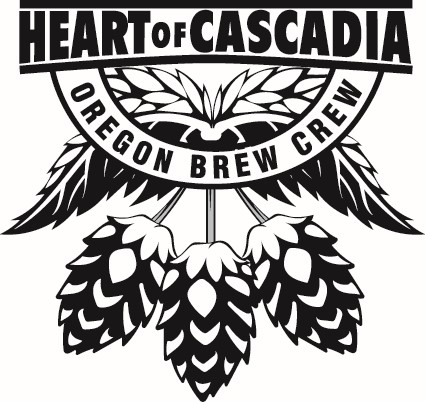11th Annual Heart of Cascadia
Thanks to all who participated in the 11th Annual Heart of Cascadia.
There were 56 entries judged and 56 registered participants, judges, and stewards.
Best of Show Winners
Best of Show – Beer
| Place | Brewer | Entry Name | Style | Club |
|---|---|---|---|---|
| 1st | Russell Berger | Myrcene, Myrcene, Myrcene | 21A: American IPA | Portland Brewers Collective |
| 2nd | Russell Berger | Darkness Imprisoning Me | 21B2: Black IPA | Portland Brewers Collective |
| 3rd | Jim Thompson | Ludicrously Capricious | 21B1: Belgian IPA | Oregon Brew Crew |
| HM | Russell Berger | Whole Lotta Leaf | 22A: Double IPA | Portland Brewers Collective |
Hoppy Brewer! (28 Participating Brewers)
Scores and tie-breakers have been applied in accordance with the scoring methodology. Numbers reflected are rounded to the hundredth place. Hover over or tap the question mark icon () for the actual calculated value.
The Hoppiest Club in the West! (9 Participating Clubs)
| Place | Club | 1st | 2nd | 3rd | HM | Score |
|---|---|---|---|---|---|---|
| 1st | Portland Brewers Collective | 4 | 5 | 2 | 1 | 73.00 |
| 2nd | Oregon Brew Crew | 4 | 3 | 4 | 1 | 67.00 |
| 3rd | Inland Brewers Unite | 0 | 1 | 1 | 0 | 9.00 |
| 4th | Cascade Brewers Society | 0 | 1 | 0 | 0 | 6.00 |
| 5th | Drib Pro Quo | 0 | 0 | 0 | 1 | 1.00 |
Scores and tie-breakers have been applied in accordance with the scoring methodology. Numbers reflected are rounded to the hundredth place. Hover over or tap the question mark icon () for the actual calculated value.
Winning Entries
Table 1: American IPA (14 entries)
| Place | Brewer | Name | Style | Club |
|---|---|---|---|---|
| 1st | Russell Berger | Myrcene, Myrcene, Myrcene | 21A: American IPA | Portland Brewers Collective |
| 2nd | Jeffrey Orr MHP | West Coast IPA | 21A: American IPA | Oregon Brew Crew |
| 3rd | Scott Nieradka | Blame Russel | 21A: American IPA | Portland Brewers Collective |
| HM | Rodney Krause | Catacomb IPA | 21A: American IPA | Drib Pro Quo |
Table 2: Hazy IPA (8 entries)
| Place | Brewer | Name | Style | Club |
|---|---|---|---|---|
| 1st | Nick DeFae | Mystic Loop | 21C: Hazy IPA | |
| 2nd | David James MHP | Neurosis | 21C: Hazy IPA | Cascade Brewers Society |
| HM | Jeffrey Orr MHP | HAZY IPA | 21C: Hazy IPA | Oregon Brew Crew |
Table 3: Double IPA (7 entries)
| Place | Brewer | Name | Style | Club |
|---|---|---|---|---|
| 1st | Russell Berger | Whole Lotta Leaf | 22A: Double IPA | Portland Brewers Collective |
| 2nd | Aaron Fernald | Altus The Shattering | 22A: Double IPA | Inland Brewers Unite |
| 3rd | Glenn Snow | Never Tell Me The Hops | 22A: Double IPA | Inland Brewers Unite |
Table 4: Fruit/Experimental/Milkshake IPA (4 entries)
Table 5: Cold/Session/Rye IPA (5 entries)
| Place | Brewer | Name | Style | Club |
|---|---|---|---|---|
| 1st | Rodney Kibzey | Free Hops From Jeff | 50A: Session IPAs | Oregon Brew Crew |
| 2nd | Quintin Murchison | White Noise Hazy Pale | 50A: Session IPAs | |
| 3rd | Adam Lund MHP | My Whole Life Is About Winning. I Don't Lose Often. I Almost Never Lose. | 54A: IPL /Cold IPA | Oregon Brew Crew |
Table 6: Black IPA (3 entries)
Table 7: English IPA (4 entries)
| Place | Brewer | Name | Style | Club |
|---|---|---|---|---|
| 1st | Steve Flanders | Medieval Harvest | 12C: English IPA | |
| 2nd | Cody Gabbard | Bollocks To Crystal | 12C: English IPA | Portland Brewers Collective |
Table 8: Hop Water (4 entries)
| Place | Brewer | Name | Style | Club |
|---|---|---|---|---|
| 1st | Rodney Kibzey | Citra-Saic | 57A: Hop Water | Oregon Brew Crew |
| 2nd | Cody Gabbard | Eau De Bois | 57A: Hop Water | Portland Brewers Collective |
